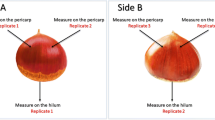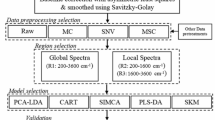Abstract
Both multi-class and one-class discrimination analyses (DAs) have been widely used for tracing the geographical origins of Protected Designation of Origin (PDO) foods. However, due to the complexity of potential non-PDO frauds, both methods have encountered some problems. Because multi-class DA tries to classify two or more predefined classes, its classification results will be unreliable when it is used to predict a new object from an untrained class. One-class DA is developed using only the information concerning one-class objects, so they cannot necessarily ensure the model specificity for detection of various food frauds. In this work, a new chemometric strategy was proposed by fusion of multi-class and one-class DA to trace the geographical origin of a Chinese dried shiitake mushroom with PDO. The PDO shiitake objects (n = 161) and non-PDO objects (n = 264) from five other main producing areas were analyzed using near-infrared spectroscopy. The classification performance of multi-class DA, one-class DA, and model fusion was compared. With second-order derivative (D2) spectra, model fusion obtained a high sensitivity (0.944) and specificity (0.968). Model comparison indicates that fusion of multi-class and one-class DA can enhance the specificity for detecting various non-PDO foods with little loss of model sensitivity.




Similar content being viewed by others
References
Barker M, Rayens M (2003) Partial least squares for discrimination. J Chemom 17:166–173
Barnes RJ, Dhanoa MS, Lister SJ (1989) Standard normal variate transformation and de-trending of near-infrared diffuse reflectance spectra. Appl Spectrosc 43:772–777
Botelho B, Reis N, Oliveira L, Sena MM (2015) Development and analytical validation of a screening method for simultaneous detection of five adulterants in raw milk using mid-infrared spectroscopy and PLS-DA. Food Chem 181:31–37
Cantarelli MÁ, Azcarate SM, Savio M, Marchevsky EJ, Camiña JM (2015) Authentication and discrimination of whiskies of high commercial value by pattern recognition. Food Anal Methods 8(3):790–798
Chandra LC, Smith BJ, Clarke SL, Marlow D, D’Offay JM, Kuvibidila SR (2011) Differential effects of shiitake- and white button mushroom-supplemented diets on hepatic steatosis in C57BL/6 mice. Food Chem Toxicol 49:3074–3080
Chang R (1996) Functional properties of edible mushrooms. Nutr Rev 54(11):S91–S93
Chiu SW, Ma AM, Lin FC, Moore D (1996) Genetic homogeneity of cultivated strains of shiitake (Lentinula edodes) used in China as revealed by the polymerase chain reaction. Mycol Res 100:1393–1399
Coppaa M, Revello-Chion A, Giaccone D, Ferlay A, Tabacco E, Borreani G (2014) Comparison of near and medium infrared spectroscopy to predict fatty acid composition on fresh and thawed milk. Food Chem 150:49–57
Diniz PHJD, Gomes AA, Pistonesi MF, Band BSF, de Araújo MCU (2014) Simultaneous classification of teas according to their varieties and geographical origins by using NIR spectroscopy and SPA-LDA. Food Anal Methods 7(8):1712–1718
Dröge JBM, Van HA, Klooster T (1987) An evaluation of SIMCA. Part 1 - the reliability of the SIMCA pattern recognition method for a varying number of objects and features. J Chemom 1:223–230
Ferreira DS, Pallone JAL, Poppi RJ (2013) Fourier transform near-infrared spectroscopy (FT-NIRS) application to estimate Brazilian soybean [Glycine max (L.) Merril] composition. Food Res Int 51(1):53–58
Forina M, Armanino C, Leardi R, Drava G (1991) A class-modelling technique based on potential functions. J Chemom 5:435–453
Gok S, Severcan M, Goormaghtigh E, Kandemir I, Severcan F (2015) Differentiation of Anatolian honey samples from different botanical origins by ATR-FTIR spectroscopy using multivariate analysis. Food Chem 170:234–240
Hatvani N (2001) Antibacterial effect of the culture fluid of Lentinus edodes mycelium grown in submerged liquid culture. Int J Antimicrob Agents 17:71–74
Hubert M, Rousseeuw PJ, Verboven S (2002) A fast method for robust principal components with applications to chemometrics. Chemometr Intell Lab Syst 60:101–111
Jiang T, Wang Q, Xu S, Jahangir MM, Ying T (2010) Structure and composition changes in the cell wall in relation to texture of shiitake mushrooms (Lentinula edodes) stored in modified atmosphere packaging. J Sci Food Agric 90:742–749
Jiang T, Feng L, Li J (2012) Changes in microbial and postharvest quality of shiitake mushroom (Lentinus edodes) treated with chitosan–glucose complex coating under cold storage. Food Chem 131:780–786
Karoui R, Baerdemaeker JD (2007) A review of the analytical methods coupled with chemometric tools for the determination of the quality and identity of dairy products. Food Chem 102:621–640
Karoui R, Downey G, Blecker C (2010) Mid-infrared spectroscopy coupled with chemometrics: a tool for the analysis of intact food systems and the exploration of their molecular structure-quality relationships-a review. Chem Rev 110:6144–6168
Kennard RW, Stone L (1969) Computer aided design of experiments. Technometrics 11:137–148
Khan MK, Krishna H, Majumder SK, Gupta PK (2015) Detection of urea adulteration in milk using near-infrared Raman spectroscopy. Food Anal Methods 8:93–102
Kowalski BR, Bender CF (1975) Solving chemical problems with pattern recognition. Naturwissenschaften 62:10–14
Krähmer A, Engel A, Kadow D, Ali N, Umaharan PW, Kroh L, Schulz H (2015) Fast and neat – determination of biochemical quality parameters in cocoa using near infrared spectroscopy. Food Chem 181:152–159
Li HB, Wu XQ, Peng HZ, Fu LZ, Wei HL, Wu QQ, Jin QY, Li N (2008) New available SCAR markers: potentially useful in distinguishing a commercial strain of the superior type from other strains of Lentinula edodes in China. Appl Microbiol Biotechnol 81:303–309
Liang YZ, Kvalheim OM, Manne R (1993) White, grey and black multicomponent systems: a classification of mixture problems and methods for their quantitative analysis. Chemometr Intell Lab Syst 18:235–250
Lin CA, Ayvaz H, Rodriguez-Saona LE (2014) Application of portable and handheld infrared spectrometers for determination of sucrose levels in infant cereals. Food Anal Methods 7(7):1407–1414
Manzi P, Pizzoferrato L (2000) Beta-glucans in edible mushrooms. Food Chem 68:315–318
Mattila P, Könkö K, Eurola M, Pihlava JM, Astola J, Vahteristo L, Hietaniemi V, Kumpulainen J, Valtonen M, Piironen V (2001) Contents of vitamins, mineral elements, and some phenolic compounds in cultivated mushrooms. J Agric Food Chem 49:2343–2348
Roza-Delgado B, Soldado A, Martinez-Fernandez A, Vicente F, Garrido-Varo A, Perez-Marin D, Haba MJ, Guerrero-Ginel JE (2007) Application of near-infrared microscopy (NIRM) for the detection of meat and bone meals in animal feeds: a tool for food and feed safety. Food Chem 105(3):1164–1170
Savitzky A, Golay MJE (1964) Smoothing and differentiation of data by simplified least squares procedures. Anal Chem 36:1627–1639
Schepetkin IA, Quinn MT (2006) Botanical polysaccharides: macrophage immunomodulation and therapeutic potential. Int Immunopharmacol 6:317–333
Scholz MBS, Pagiatto NF, Kitzberger CSG, Pereira LFP, Davrieux F, Charmetant P, Leroy T (2014) Validation of near-infrared spectroscopy for the quantification of cafestol and kahweol in green coffee. Food Res Int 61:176–182
Weihs C, Baumeister W, Schmidli H (1993) Short communication classification methods for multivariate quality parameters. J Chemom 7:131–142
Xu QS, Liang YZ (2001) Monte Carlo cross validation. Chemometr Intell Lab Syst 56:1–11
Xu L, Xu QS, Yang M, Zhang HZ, Cai CB, Jiang JH, Wu HL, Yu RQ (2011) On estimating model complexity and prediction errors in multivariate calibration: generalized resampling by random sample weighting (RSW). J Chemom 25:568–574
Xu L, Ye ZH, Yan SM, Shi PT, Cui HF, Fu XS, Yu XP (2012) Combining local wavelength information and ensemble learning to enhance the specificity of class modeling techniques: identification of food geographical origins and adulteration. Anal Chim Acta 754:31–38
Xu L, Yan SM, Cai CB, Yu XP (2013) One-class partial least squares (OCPLS) classifier. Chemometr Intell Lab Syst 126:1–5
Acknowledgments
This work was financially supported by the General and Youth Projects of National Natural Science of China (Grant Nos. 21476270, 21276006, and 21205145). Lu Xu is also grateful to the financial support from the Open Research Program (No. GCTKF2014007) of State Key Laboratory Breeding Base of Green Chemistry Synthesis Technology (Zhejiang University of Technology) and the Research Fund for the Doctoral Program of Tongren University (No. trxyDH1501).
Compliance with Ethical Standards
This article does not contain any studies with human participants or animals performed by any of the authors.
Conflict of Interest
Lu Xu declares that he has no conflict of interest. Hai-Yan Fu declares that she has no conflict of interest. Tian-Ming Yang declares that he has no conflict of interest. Yuan-Bin She declares that he has no conflict of interest. He-Dong Li declares that he has no conflict of interest. Chen-Bo Cai declares that he has no conflict of interest. Li-Juan Chen declares that she has no conflict of interest.
Author information
Authors and Affiliations
Corresponding authors
Additional information
Lu Xu and Hai-Yan Fu equally contributed to this work.
Rights and permissions
About this article
Cite this article
Xu, L., Fu, HY., Yang, TM. et al. Enhanced Specificity for Detection of Frauds by Fusion of Multi-class and One-Class Partial Least Squares Discriminant Analysis: Geographical Origins of Chinese Shiitake Mushroom. Food Anal. Methods 9, 451–458 (2016). https://doi.org/10.1007/s12161-015-0213-8
Received:
Accepted:
Published:
Issue Date:
DOI: https://doi.org/10.1007/s12161-015-0213-8




